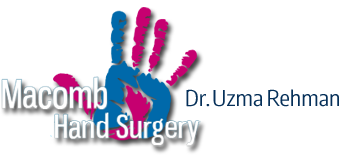Causes of Collarbone Pain – from Mild to Serious
The collarbone, medically called the clavicle, is a slender, S-shaped bone located in the front of the chest, connecting the sternum (breastbone) to the shoulder blade (scapula). Its primary role is to provide structural support and serve as an anchor for various muscles and ligaments. The collarbone is crucial for shoulder movement and stability, making it an essential part of the upper body’s functionality.
Collarbone pain can range from mild discomfort to serious agony. But whether slight or severe, collarbone pain can significantly interfere with an individual’s daily life and activities. However, knowing when to see a doctor and when to “ride it out” can be challenging.
In this article, board-certified Detroit area hand doctor Uzma Rehman, MD will explore the causes of collarbone pain, its location and function, common conditions that may lead to this discomfort, diagnostic approaches, treatment options, and the significance of consulting a specialist for collarbone pain.
Most Common Causes of Collarbone Pain
A broken collarbone (clavicle fracture) is one of the most prevalent causes of collarbone pain. A fracture or break in the clavicle, often results from falls, sports injuries, or bicycle or car accidents. A broken collarbone can be a “hairline fracture” or a more serious break. But, as with ANY broken bone, seeing a specialist as soon as possible is essential to ensure properly aligned healing and prevent long-term deformity, misalignment, or permanent pain and/or loss of mobility.
Thoracic Outlet Syndrome (TOS) is another cause of clavicle pain. TOS occurs when nerves or blood vessels are compressed as they pass through the thoracic outlet, which can lead to collarbone pain, tingling, and numbness in the arm and hand.
Collarbone pain can also be the result of Osteoarthritis. When arthritis results in the degeneration of cartilage at the acromioclavicular (AC) joint – where the collarbone meets the shoulder blade – can cause collarbone pain, as well as limited range of motion.
Distal Clavicular Osteolysis is another condition that can cause acute or chronic collarbone discomfort. This disease involves the gradual erosion of the bone at the end of the clavicle, leading to pain, inflammation, stiffness, and discomfort in the shoulder region.
Osteomyelitis is a fairly rare but serious infection of the collarbone. Osteomyelitis can result in intense collarbone pain, swelling, and fever and must be treated immediately to halt progression and complications from the infection. Any time pain is accompanied by swelling and fever it is crucial to seek medical treatment immediately.
How Doctors Diagnose Collarbone Pain
Diagnosing the cause of collarbone pain often requires a comprehensive evaluation. Dr. Rehman will typically begin with a thorough evaluation of your medical history: discussing your symptoms, health history, activities at the time of pain onset, and any recent injuries.
She will also conduct a thorough examination of the collarbone, shoulder, and neck to assess range of motion and pinpoint areas of pain and tenderness.
Imaging including X-rays, CT scans, or MRI scans may then be employed to visualize the collarbone and surrounding structures, helping to identify fractures, joint issues, or soft tissue problems.
How Collarbone Pain is Treated
Treatment for collarbone pain will vary based on what Dr. Rehman determines the underlying cause to be:
For a clavicle fracture, treatment may involve immobilization with a sling. More severe collarbone fractures may require surgery.
For Thoracic Outlet Syndrome, physical therapy, posture correction, and lifestyle modifications can often be sufficient to alleviate the pain and symptoms that are the result of the compressed nerves.
For more severe disorders, including osteoarthritis and distal clavicular osteolysis, conservative measures like physical therapy, pain medications, anti-inflammatory medications, rest, and lifestyle adjustments are usually the first round of treatments aimed at managing pain or discomfort. Severe cases, however, may require surgery.
For an osteomyelitis infection, however, aggressive antibiotic treatment should be started immediately. And, in severe cases, surgery to drain abscesses or remove infected tissue may be required.
Collarbone Pain Specialist | Detroit Area
As you can see, collarbone pain can originate from various causes, some of which may require immediate specialized care and treatment. Consulting with a specialist, like board-certified surgeon Uzma Rehman, MD in the Detroit area is crucial for accurate diagnosis, rapid intervention, and personalized treatment plans tailored to your specific condition.
Collarbone pain can disrupt daily life and hinder mobility, but it is essential to remember that many effective treatments are available. Early diagnosis and appropriate intervention, by a specialist like Dr. Rehman in the Detroit area, can help you regain comfort and function, allowing you to resume your normal activities. If you are experiencing persistent collarbone pain, schedule an appointment with Dr. Rehman today and take the first step toward a pain-free future.

